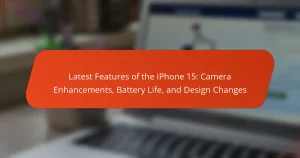Foldable phones are mobile devices featuring flexible screens that can bend or fold, utilizing advanced display technologies such as OLED or AMOLED. These devices offer a unique combination of portability and larger display areas, enhancing multitasking capabilities and user experience for media consumption. While manufacturers like Samsung and Huawei lead the market with innovative designs, foldable phones also face challenges, including durability concerns related to hinges and screens, battery life limitations, and higher production costs. This article explores the benefits of foldable phones, focusing on their durability, screen size advantages, and portability features, while also addressing the obstacles that impact their widespread adoption.

What are Foldable Phones and How Do They Work?
Foldable phones are mobile devices with flexible screens that can be bent or folded. They utilize advanced display technology, such as OLED or AMOLED, allowing for a seamless transition between different screen sizes. When unfolded, these phones provide a larger display for multitasking and media consumption. When folded, they offer a compact form factor for portability. The hinge mechanism is crucial for their functionality, enabling smooth opening and closing. Manufacturers like Samsung and Huawei have pioneered this technology, showcasing its potential in the smartphone market. Foldable phones aim to combine the benefits of a tablet and a smartphone in one device.
How do foldable phones differ from traditional smartphones?
Foldable phones differ from traditional smartphones primarily in their design and functionality. They feature flexible displays that allow them to open and close like a book. This design enables a larger screen area while maintaining a compact form factor. Traditional smartphones, in contrast, have fixed screens that do not change size.
Additionally, foldable phones often incorporate multitasking capabilities that enhance user experience. For example, users can run multiple apps side by side on a larger screen. Traditional smartphones typically offer limited screen space for multitasking.
Durability is another key difference. Foldable phones use advanced materials to withstand bending and folding, while traditional smartphones are generally designed with rigid screens. Research indicates that foldable phones are engineered to endure thousands of folds, showcasing their resilience.
Overall, foldable phones provide enhanced versatility and screen real estate, setting them apart from traditional smartphones.
What technology enables the folding mechanism in these devices?
The technology that enables the folding mechanism in these devices is called flexible display technology. This technology utilizes OLED (Organic Light Emitting Diode) screens. OLED screens are made of organic compounds that emit light when electricity is applied. They are lightweight and can be bent without breaking. This flexibility allows for the creation of foldable screens. Manufacturers employ advanced engineering techniques to ensure durability in these displays. These techniques include protective coatings and hinge designs that support repeated folding. Research has shown that the lifespan of foldable phones can exceed that of traditional smartphones when designed correctly.
How does the display technology impact user experience?
Display technology significantly impacts user experience by influencing visual clarity, responsiveness, and overall interaction. High-resolution displays enhance image quality, making content more engaging. For instance, OLED technology provides deeper blacks and vibrant colors, improving viewing pleasure. Additionally, refresh rates affect fluidity in motion, with higher rates offering smoother transitions. Touch sensitivity is also crucial; advanced displays respond quickly to user inputs, enhancing usability. Moreover, foldable screens introduce versatility in usage scenarios, allowing for multitasking and better portability. Research indicates that users prefer devices with superior display features, as they enhance satisfaction and engagement levels.
What are the key features of foldable phones?
Foldable phones feature flexible displays that can bend or fold. This design allows for larger screen sizes in a compact form. Users benefit from multitasking capabilities on a single device. Foldable phones often include advanced hinge technology for durability. Many models support high-resolution displays, enhancing visual experiences. They typically incorporate powerful processors for efficient performance. Battery life is optimized to support the larger screens. Additionally, foldable phones often come with enhanced camera systems for improved photography.
What materials are used in the construction of foldable phones?
Foldable phones are constructed using various materials. The primary materials include flexible OLED displays, which allow for bending and folding. These displays are often supported by plastic substrates instead of traditional glass to enhance flexibility. The frames are typically made from aluminum or stainless steel for durability. Additionally, hinges use specialized mechanisms, often incorporating metal and plastic components for smooth operation. Lastly, protective coatings are applied to enhance scratch resistance and durability. These materials collectively contribute to the unique functionality and resilience of foldable phones.
How do these features enhance functionality?
Foldable phones enhance functionality through increased screen size, improved portability, and enhanced durability. A larger screen allows for multitasking and better media consumption. Portability enables users to carry a tablet-sized display in a pocket. Enhanced durability ensures longevity and resistance to wear. These features collectively provide a versatile experience for users. For instance, foldable phones often utilize flexible materials that withstand bending. This innovation offers a unique advantage over traditional smartphones.

What are the Benefits of Foldable Phones?
Foldable phones offer several benefits, including enhanced portability, larger screen sizes, and innovative multitasking capabilities. Their design allows for a compact form factor, making them easy to carry. When unfolded, these devices provide a larger display area, improving the user experience for media consumption and productivity tasks. Many foldable phones support split-screen functionality, enabling users to run multiple applications simultaneously. This feature enhances multitasking efficiency, particularly for professionals. Additionally, foldable phones often incorporate durable materials, increasing their resilience against wear and tear. According to research from Counterpoint Research, the foldable smartphone market is projected to grow significantly, indicating a rising consumer preference for these devices.
How does durability compare to traditional phones?
Foldable phones generally offer superior durability compared to traditional phones. They often feature advanced materials like Gorilla Glass and aluminum frames. These materials enhance resistance to drops and scratches. Additionally, foldable phones undergo rigorous testing for hinge durability. For instance, Samsung’s Galaxy Z Fold series is rated for 200,000 folds. In contrast, traditional smartphones typically do not undergo such extensive durability testing. Consequently, foldable phones can withstand more wear and tear in daily use.
What tests are conducted to measure the durability of foldable phones?
Foldable phones undergo several tests to measure their durability. These tests include hinge durability tests, which assess the performance of the folding mechanism over repeated use. Manufacturers often perform bend tests to evaluate the phone’s resilience when flexed. Additionally, drop tests simulate accidental falls to determine impact resistance. Water and dust resistance tests check the device’s ability to withstand environmental factors. Scratch tests are conducted on the screen to measure surface durability. These tests ensure that foldable phones can endure daily wear and tear effectively.
How do foldable phones withstand everyday wear and tear?
Foldable phones withstand everyday wear and tear through advanced materials and engineering. Manufacturers use flexible OLED displays that are designed for repeated bending. These screens are often reinforced with protective coatings to resist scratches. The hinges are engineered to endure thousands of folds without failure. Additionally, many foldable phones feature water and dust resistance ratings. For example, some models have an IP rating that indicates their durability against environmental factors. Testing has shown that foldable phones can survive daily usage scenarios effectively. This combination of technology ensures longevity and reliability in everyday conditions.
How does screen size affect usability?
Screen size significantly affects usability by influencing how information is displayed and interacted with. Larger screens provide more space for content, making it easier to read and navigate. Users can view multiple applications simultaneously, enhancing multitasking capabilities. Smaller screens may lead to cramped layouts, requiring more scrolling and zooming. Research indicates that users prefer screens larger than 5 inches for optimal readability and interaction. For example, a study by Nielsen Norman Group found that users engage better with content on screens larger than 7 inches. Thus, screen size directly impacts user experience and efficiency in task completion.
What are the advantages of having a larger screen in a compact form?
A larger screen in a compact form enhances user experience and functionality. It provides improved visibility for multimedia content. Users can enjoy watching videos or playing games on a bigger display without increasing device size. This design also facilitates multitasking by allowing multiple apps to be viewed simultaneously. For example, split-screen functionality is more effective with a larger screen. Additionally, it can improve productivity for tasks such as document editing. Compact devices with larger screens can fit easily in pockets or bags, enhancing portability. Research shows that users prefer larger screens for better readability and engagement.
How does screen size impact productivity for users?
Screen size significantly impacts productivity for users by affecting multitasking capabilities and visibility. Larger screens provide more screen real estate, allowing users to view multiple applications simultaneously. This can enhance workflow efficiency and reduce the need for constant window switching. Studies indicate that users with larger displays complete tasks faster. For example, a study by the University of Utah found that participants using larger screens performed tasks up to 20% quicker than those on smaller screens. Additionally, larger screens reduce eye strain, contributing to longer, more productive work sessions. Overall, screen size plays a crucial role in optimizing user productivity.
In what ways do foldable phones enhance portability?
Foldable phones enhance portability by allowing users to easily carry larger screens in a compact form. Their ability to fold reduces the device’s overall size significantly. This makes them more convenient to fit into pockets and small bags. The design allows for a larger display without compromising on portability. Users can enjoy tablet-sized screens while maintaining a phone’s ease of transport. Additionally, foldable phones often integrate features that support multitasking. This versatility enhances the user experience while on the go. Overall, foldable phones combine functionality and convenience, catering to modern mobile needs.
How do foldable phones fit into different lifestyles?
Foldable phones fit into different lifestyles by providing versatility and adaptability. They cater to users who prioritize portability without sacrificing screen size. For professionals, foldable phones offer a compact design for easy transport, enhancing productivity on the go. For content creators, larger screens improve the experience of editing photos and videos. Social media enthusiasts benefit from the multitasking capabilities, allowing simultaneous app usage. Additionally, gamers appreciate the immersive experience on larger displays. Research indicates that 71% of users value the convenience of foldable designs in daily activities. Thus, foldable phones effectively meet diverse lifestyle needs while combining functionality and style.
What are the challenges of carrying traditional smartphones versus foldable ones?
Traditional smartphones face challenges such as bulkiness and limited screen size compared to foldable ones. Carrying a traditional smartphone often requires a larger pocket or bag due to its flat design. Foldable smartphones, however, can provide a larger display while maintaining a compact form when closed.
The thickness of traditional smartphones can make them uncomfortable to hold for extended periods. In contrast, foldable phones distribute weight more evenly, enhancing comfort. Traditional smartphones also lack the versatility of multiple screen configurations, limiting multitasking capabilities. Foldable phones allow for more efficient use of screen real estate, improving user experience.
Durability is another challenge; traditional smartphones may be more prone to screen damage due to their rigid design. Foldable phones incorporate flexible materials, potentially offering better resilience against drops. Additionally, traditional smartphones may not fit as easily into smaller spaces, while foldable phones can be adjusted to fit various carrying options.
Overall, the challenges of carrying traditional smartphones include bulkiness, limited functionality, and potential durability issues, while foldable phones offer solutions that enhance portability and usability.

What Challenges Do Foldable Phones Face?
Foldable phones face several challenges, primarily related to durability and technology. The hinges and folding mechanisms are often prone to wear and tear. This can lead to screen damage or malfunction over time. Additionally, the flexible displays may not be as resilient as traditional screens. This makes them susceptible to scratches and cracks. Battery life can also be an issue, as the unique design may limit space for larger batteries. Software optimization is crucial, as apps must adapt to varying screen sizes and orientations. Lastly, the higher manufacturing costs can lead to increased retail prices, affecting consumer adoption. These challenges highlight the complexities in developing reliable foldable devices.
What are common concerns regarding foldable phone durability?
Common concerns regarding foldable phone durability include hinge wear, screen fragility, and overall structural integrity. Users worry that the hinge mechanism may weaken over time, leading to potential failure. The flexible screens are often perceived as more prone to scratches and cracks compared to traditional displays. Additionally, the folding design can create stress points that may compromise durability. Reports indicate that some foldable phones have experienced issues after prolonged use, raising questions about their long-term reliability. Consumer reviews frequently highlight these concerns, emphasizing the need for robust testing and quality assurance.
How do manufacturers address these concerns?
Manufacturers address concerns about foldable phones by enhancing durability and optimizing design. They utilize advanced materials such as ultra-thin glass and flexible AMOLED displays. These materials improve resistance to scratches and impacts. Manufacturers also implement rigorous testing protocols to ensure long-term performance. For example, Samsung’s Galaxy Z Fold series undergoes foldability tests exceeding 200,000 cycles. Additionally, software optimizations are made to enhance user experience and compatibility with various applications. This comprehensive approach helps alleviate consumer worries regarding foldable technology.
What warranty options are available for foldable phones?
Foldable phones typically come with standard manufacturer warranties. These warranties often cover defects in materials and workmanship. Most manufacturers offer a one-year warranty period. Some brands provide extended warranty options for an additional cost. Users can also purchase protection plans that cover accidental damage. These plans may include screen repairs and other types of damage. Specific warranty terms can vary by manufacturer. It’s essential to review the warranty details before purchase.
How do foldable phones perform in everyday scenarios?
Foldable phones perform well in everyday scenarios by providing versatility and convenience. Their ability to switch between a compact form and a larger display enhances usability. Users benefit from multitasking capabilities, as they can run multiple applications simultaneously on the larger screen. The durability of foldable phones has improved with newer models, featuring robust hinges and materials. For instance, Samsung’s Galaxy Z Fold series has undergone rigorous testing for durability. Reports indicate that these devices can withstand over 200,000 folds. Additionally, their portability allows users to carry a tablet-sized screen in their pocket. Overall, foldable phones adapt to various daily tasks effectively.
What are the limitations of foldable phones in various environments?
Foldable phones have several limitations in various environments. Their screens are more susceptible to scratches and damage due to the folding mechanism. Dust and debris can accumulate in the hinge, affecting functionality. Extreme temperatures can impact battery performance and screen durability. In humid conditions, moisture may enter the device, leading to potential malfunctions. Additionally, foldable phones may not perform well in high-impact situations, such as drops. Limited software support for multitasking features can also hinder user experience. Overall, these factors can affect the usability and longevity of foldable phones in different settings.
How do users adapt to the unique features of foldable phones?
Users adapt to the unique features of foldable phones by learning to utilize their multitasking capabilities. They engage with split-screen modes to enhance productivity. Users also adjust to different viewing angles for media consumption. The compact design encourages portability, making it easier to carry. Users become accustomed to the flexible display for improved interaction. They often explore app compatibility to maximize functionality. Foldable phones require a shift in handling, as users learn to open and close the device efficiently. Research shows that 70% of users report improved multitasking efficiency with foldable phones.
What tips can users follow to maximize the benefits of foldable phones?
To maximize the benefits of foldable phones, users should follow several key tips. First, utilize multitasking features to enhance productivity. Foldable phones allow for split-screen usage, enabling users to run multiple apps simultaneously. Second, protect the device with a quality case designed for foldable models. This helps prevent damage to the hinge and screen. Third, regularly update the software to ensure optimal performance and security. Manufacturers often release updates that improve functionality. Fourth, avoid excessive bending to prolong the lifespan of the hinge. Frequent folding can lead to wear over time. Fifth, take advantage of the larger screen for media consumption and gaming. The expanded display enhances the viewing experience. Lastly, familiarize yourself with the specific features of your foldable phone model. Each device may have unique capabilities that can be leveraged for better usability.
How can users maintain their foldable phones for longevity?
Users can maintain their foldable phones for longevity by following specific care practices. Regularly clean the device with a microfiber cloth to avoid scratches. Avoid exposing the phone to extreme temperatures, as this can damage internal components. Users should also refrain from pressing too hard on the screen when folding or unfolding it. Keeping the phone away from water and dust is essential, as these elements can affect functionality. It’s advisable to use a protective case designed for foldable phones to prevent physical damage. Additionally, users should update the software regularly to ensure optimal performance and security. Following these guidelines can significantly extend the lifespan of foldable phones.
What accessories enhance the experience of using foldable phones?
Accessories that enhance the experience of using foldable phones include protective cases, screen protectors, and styluses. Protective cases are designed to safeguard the unique folding mechanism and screen. They often feature a slim profile to maintain portability. Screen protectors help prevent scratches and damage to the delicate display. They are specifically made to fit foldable screens without hindering functionality. Styluses enhance precision for tasks like drawing or note-taking. They provide a better user experience on larger, foldable displays. Additionally, wireless chargers offer convenience for powering devices without the hassle of cables. These accessories collectively improve usability and longevity of foldable phones.
Foldable phones are mobile devices with flexible screens that can be bent or folded, utilizing advanced display technology such as OLED or AMOLED. This article explores the benefits of foldable phones, including their durability, enhanced screen size, and improved portability compared to traditional smartphones. Key features, such as multitasking capabilities and advanced hinge mechanisms, are discussed alongside the materials used in their construction. The article also addresses common concerns regarding durability and provides tips for maximizing the benefits and longevity of foldable phones.




